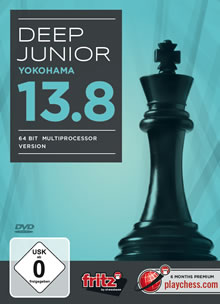
Deep Junior 13.8 mulitprocessor version
2014
http://www.chessbase.com
E-Mail info@chessbase.com
Price Euro 79.90
System requirements:
Minimum: Pentium III 1 GHz, 2 GB RAM, Windows Vista, XP (Service Pack
3), 7/8, DirectX9, 256 MB graphics card, DVD-ROM
drive, Windows Media Player 9 and Internet access for program
activation, access to Playchess.com, Let’s Check and program updates.
Recommended: PC Intel i5 (Quadcore), 4 GB RAM, Windows 8.1, DirectX10,
512 MB graphics card, 100% DirectX10-compatible
sound card, Windows Media Player 11, DVD-ROM drive and Internet access
for program activation, access to Playchess.com,
Let's Check and program updates
Deep Junior is back and how! This incredible killing
machine
understands tactical play much better than more expensive engines as
Fritz or Houdini.
This is the perfect engine for players who prefer sharp lines as the
Marshall
Gambit,because Junior Yokohama will play lines that are hardly
touched by other engines, as for example after the moves:1.e4 e5 2.Nf3
Nc6 3.Bb5 a6 4.Ba4 Nf6 5.0-0 Be7 6.Re1 b5
7.Bb3 0-0 8.c3 d5 9.exd5 Nxd5
10.Nxe5 Nxe5 11.Rxe5 c6 12.d4 Bd6
13.Re1 Qh4 14.g3 Qh3 15.Be3 Bg4 16.Qd3 Rae8 17.Nd2 Qh5 18.a4 Re6
19.axb5 axb5 20.Bxd5!?
The Power book move here is 20.Qf1. Funny enough Deep Fritz prefers
here 10.Nf1.
After: 1.e4 e5 2.Nf3 f5 3.Bc4 fxe4 4.Nxe5 d5 The Svedenborg’s
Variation,called after the Norwegian player Svedenborg but this move
was already
quoted by the good old Bilguer,back in 1843. 5.Qh5+ g6 6.Nxg6
hxg6 7.Qxg6+ Kd7 8.Bxd5 Nf6 9.Nc3 Deep Junior Yokohama
considers moves as 9…c6 and 9….Bc5.
Tony Kosten only considers in his book The Latvian gambit
Lives! 9….Nc6!? as an alternative.
In the Poisoned g2 Pawn Variation Deep Junior gave me new moves as:
1.e4 e5 2.Nf3 f5 3.Bc4 fxe4 4.Nxe5 Qg5 5.d4 Qxg2 6.Qh5+ g6 7.Bf7+ Kd8
8.Bxg6 Qxh1+ 9.Ke2 Qxc1 10.Nf7+ Ke8 11.Nxh8+ hxg6
12.Qxg6+ Kd8 13.Nf7+ Ke7 14.Nc3 Qxc2+ 15.Ke1 d6 16.Nd5+ Kd7 17.Qxg8
Qxb2 18.Rd1 Qa3!?
In the famous Fischer – Tal game from Leipzig 1960,Deep Junior Yokohama
comes with the new move 14.Rb1!?
Fischer,Robert James - Tal,Mihail [C17]
Leipzig ol (Men) fin-A Leipzig (5), 01.11.1960
1.e4 e6 2.d4 d5 3.Nc3 Bb4 4.e5 c5 5.a3 Ba5 6.b4 cxd4 7.Qg4 Ne7 8.bxa5
dxc3 9.Qxg7 Rg8 10.Qxh7 Nbc6
11.Nf3 Qc7 12.Bb5 Bd7 13.0-0 0-0-0 14.Bg5 {14.Rb1!?N} Nxe5 15.Nxe5 Bxb5
16.Nxf7 Bxf1 17.Nxd8 Rxg5
18.Nxe6 Rxg2+ 19.Kh1 Qe5 20.Rxf1 Qxe6 21.Kxg2 Qg4+ ½-½
Deep Junior comes with the new Deep Fritz 64-bit program interface (+
32 bit program interface) Online access
to the world’s largest
database “Let’s Check”, with over 200 million extensively
analysed positions. Access to ChessBase engine cloud
Premium membership to a rustenPlaychess.com (6 months) Database with
over 1.5 million games
etc.
Conclusion: Deep Junior has become a tactical monster!
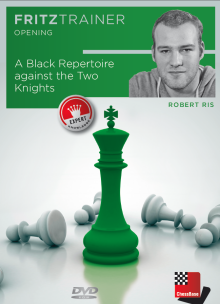
Training / Opening / Friztrainer
A Black Repertoire against the Two Knights by Robert Ris
2014
http://www.chessbase.com
E-Mail info@chessbase.com
Price Euro 29.90
Pentium-Processor at 300 Mhz or higher, 64 MB RAM, Windows XP, Windows
Vista, Windows 7, DVD drive, mouse, soundcard
Grandmaster Robert Ris provides the user of this DVD with
a very
interesting repertoire line DVD based, on the exciting Traxler or
as the
English say,the Wilkes-Barre variation where black must be prepared to
sacrifice.
And be aware if you like to play 1.e4 e5 2.Nf3 Nc6 3.Bc4 Nf6 4.Ng5
Bc5!? You must have a good memory and a great love for
tactics,other
wise go for one or other alternative which are also included on this
heavy loaded DVD.
For example: Jakymov,Volodymyr (2281) - Mamedyarov,Shakhriyar (2493)
[C56]
EU-ch U16 Chalkidiki (2), 01.09.2001
1.e4 e5 2.Bc4 Nf6 3.d4 exd4 4.Nf3 Nc6 5.0-0 Nxe4 6.Re1 d5 7.Bxd5 Qxd5
8.Nc3 Qa5 9.Nxe4 Be6 10.Neg5 0-0-0 11.Nxe6 fxe6
12.Rxe6 Bd6 13.Qe2 Qh5 14.Bd2 d3 15.Qe4 Nd4 16.h3 Nxf3+ 17.Qxf3 Qxf3
18.gxf3 dxc2 19.Rc1 Bh2+ 20.Kxh2 Rxd2
21.Kg3 Kd7 22.Re3 Re8 23.Rxe8 Kxe8 24.f4 c5 25.Kf3 c4 26.Ke3 Rd3+
27.Ke4 Rxh3 28.Rxc2 b5 29.f3 Rh6 30.a4 a6
31.axb5 axb5 32.Rg2 Re6+ 33.Kd4 Kf7 34.Kc5 Rf6 35.Kxb5 Rxf4 36.Rg4 Rxf3
37.Kxc4 h5 38.Rg1 Kf6 39.b4 Rf2
40.Rb1 Rc2+ 41.Kd5 h4 42.b5 h3 43.b6 h2 44.Rh1 Rb2 45.Kc6 Ke6 46.b7 g5
47.Re1+ Kf5 48.Rh1 Rc2+ 49.Kd7 Rb2
50.Kc6 Rc2+ 51.Kd7 ½-½
Complicated are lines after 1.e4 e5 2.Nf3 Nc6 3.Bc4 Nf6 4.Ng5 Bc5
5.Nxf7 Bxf2+ 6.Kxf2 Nxe4+ 7.Ke3 but I am missing here
correspondence games with there latest developments,
because there is much more material than the video analyses from Ris
show us here.
By the way,interesting to mention is the following lost from Bobby
Fischer: Fischer,Robert James - Henry,Robert L [C57]
San Francisco sim San Francisco, 1964
1.e4 e5 2.Nf3 Nc6 3.Bc4 Nf6 4.Ng5 Bc5 5.Bxf7+ Ke7 6.Bd5 Rf8 7.0-0 h6
8.Nf3 d6 9.Bxc6 bxc6 10.d4 exd4 11.Nxd4 Kf7
12.Nc3 Kg8 13.Nxc6 Qe8 14.Nd5 Nxd5 15.exd5 Ba6 16.c4 Bxc4 17.Bxh6 Bxf1
18.Qg4 Bxf2+ 19.Kh1 Bxg2+ 20.Qxg2 Qf7
21.Rf1 Rae8 22.h3 Bg3 23.Rxf7 Re1+ 24.Qg1 Rxg1+ 25.Kxg1 Rxf7 26.Be3 a6
27.Kg2 Be1 28.b4 Kh7 29.a3 Rf5 30.Nb8 a5 31.bxa5 Bxa5 0-1.
Included is an extra database from over 50 entries.
Video running time: 5 hours 40 min (English)
Conclusion: Very exciting!
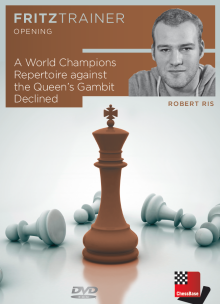
Training / Opening / Friztrainer
A World Champion's Repertoire against the Queen's Gambit Declined
by Robert Ris
2014
http://www.chessbase.com
E-Mail info@chessbase.com
Price Euro 29.90
Pentium-Processor at 300 Mhz or higher, 64 MB RAM, Windows XP, Windows
Vista, Windows 7, DVD drive, mouse, soundcard
Grandmaster Robert Ris does not only explain in his 16 video
files all
the ideas and strategies, behind the Queen’s
Gambit Declined 1.d4 d5 2.c4 e6 3.Nc3 Nf6 4.cxd5 exd5 5.Bg5 c6
6.Qc2,but also covers a lot of latest information as for example the
following game:
Vitiugov,Nikita (2729) - Halkias,Stelios (2568) [D31]
29th ECC Open 2013 Rhodes GRE (3.3), 22.10.2013
1.c4 e6 2.Nc3 d5 3.d4 Be7 4.cxd5 exd5 5.Bf4 c6 6.e3 Bd6 7.Qf3 Ne7
8.Bxd6 Qxd6
9.Bd3 b6 10.Nge2 Ba6 11.Bc2 Nd7 12.0-0-0 0-0 13.Nf4 Ng6 14.Nh5 b5
15.Ne2 Nb6
16.Qg3 Nc4 17.Nef4 Qb4 18.Nd3 Qa5 19.Bb3 Qd8 20.h4 Nd6 21.Nc5 Bc8
22.Bc2 Nf5
23.Bxf5 Bxf5 24.Nxg7 Kxg7 25.h5 Qf6 26.Rh2 Kh8 27.hxg6 fxg6 28.Rdh1 Rf7
29.Rh6 Rg8
30.Kd2 Re8 31.Qh2 Qe7 32.a3 Bg4 33.Qg3 Bh5 34.Nd3 Qf8 35.R1xh5 gxh5
36.Rxh5 Re6
37.Qh4 b4 38.axb4 Ref6 39.f4 Re6 40.g4 Rfe7 41.f5 Re4 42.Ne5 R4xe5
43.dxe5 Rg7
44.Ke2 Qxb4 45.Qd8+ Rg8 46.Qf6+ Rg7 47.Rg5 Qe7 48.Qxg7+ Qxg7 49.Rxg7
Kxg7 50.b4 1-0.
The key idea for black in many structures is to place the dark squared
bishop on the b8-h2 diagonal in
order to put pressure on white’s kingside,while at the same time
defending his weak queenside dark squares,but as we can see in the
following game it is all not so easy for black: Lputian,Smbat G (2545)
- Petrosian,Arshak B (2495) [D35]
Yerevan Yerevan, 1986
1.d4 d5 2.c4 e6 3.Nc3 Be7 4.cxd5 exd5 5.Bf4 c6 6.e3 Nf6 7.Bd3 Nbd7 8.h3
Nf8 9.Nf3 Ng6 10.Bg3 Bd6 11.Ne5 Qc7
12.f4 Ne7 13.Qc2 Nh5 14.Bf2 g6 15.g4 Ng7 16.Bh4 0-0 17.0-0-0 f6 18.Nf3
Bd7 19.Kb1 Kh8 20.Qg2 c5 21.dxc5 Qxc5
22.Bf2 Qa5 23.h4 Nc6 24.Bxg6 d4 25.Nxd4 hxg6 26.Ndb5 Ne5 27.fxe5 Bc6
28.e4 Bxe5 29.Nd4 Rae8 30.h5 g5 31.Qf3 Ne6
32.Qf5 Nxd4 33.Bxd4 Qb4 34.Qf2 Bxd4 35.Rxd4 Qc5 36.Rf1 Qe5 37.Nd5
Rd8 38.Rfd1 Rd6 39.Nc3 Rfd8 40.Rxd6 Rxd6
41.Rxd6 Qxd6 42.Qf5 Qd4 43.a3 Bd7 44.Qg6 Be6 45.Ka1 Qd8 46.e5 Bxg4
47.h6 Qd7 48.exf6 Be6 49.Qxg5 Kh7 50.b4 Qc7 51.Ne4 Qd7
52.Nd6 Qc7
53.Kb2 Qd7 54.f7 1-0.
Running time is 5 hours (English) and there is a extra database
included from over 75 entries.
Conclusion: Well explained, high class
material!
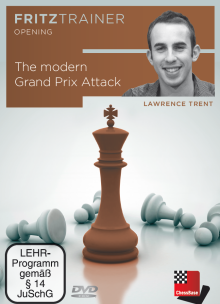
Training / Opening / Friztrainer
The modern Grand Prix Attack by Lawrene Trent
2014
http://www.chessbase.com
E-Mail info@chessbase.com
Price Euro 27.90
Pentium-Processor at 300 Mhz or higher, 64 MB RAM, Windows XP, Windows
Vista, Windows 7, DVD drive, mouse, soundcard
International master Lawrence Trent presents here a
enjoyable
repertoire for white with the sharp and dangerous Grand Prix Attack.
This opening leads to complicated play right from move one,and it was
the great Evgeny Svesnikov who wrote in his book
The Grand Prix Attack that the move 2.f4 is one of white’s deadliest
weapons against the Sicilian Defence.
As we can see in the following model game,Trent knows what he is doing
here on this DVD:
Trent,Lawrence (2429) - Tilicheev,Viacheslav (2415) [B23]
Kesarovski Georgiev Memorial-A 12th Sunny Beach (9), 08.09.2013
1.e4 c5 2.Nc3 Nc6 3.Bb5 g6 4.Bxc6 dxc6 5.f4 Bg7 6.Nf3 Nf6 7.0-0 0-0
8.Qe1 Nd7 9.d3 Re8 10.f5 Ne5
11.Kh1 e6 12.fxg6 fxg6 13.Nxe5 Bxe5 14.Bh6 Bd7 15.Nd1 Qe7 16.Ne3 Bg7
17.Bxg7 Qxg7 18.Qg3 e5
19.h4 h6 20.Rf3 Rf8 21.Raf1 Rxf3 22.Rxf3 Rf8 23.Rxf8+ Kxf8 24.Nc4 Be8
25.Nxe5 Ke7 26.Nf3 c4
27.Qe5+ Qxe5 28.Nxe5 cxd3 29.Nxd3 Kf6 30.Kg1 g5 31.hxg5+ Kxg5 32.Kf2
Kg4 33.g3 Kg5 34.c4 Bf7
35.b3 Be6 36.c5 h5 37.Kf3 Bg4+ 38.Ke3 Be6 39.Nf2 b6 40.Kd4 Bg8 41.cxb6
axb6 42.Ke5 c5 43.Kd6 c4
44.bxc4 Bxc4 45.a3 b5 46.Kc5 Be2 47.Kd5 Bf1 48.Kd4 Be2 49.Ke3 Bc4
50.Kf3 Be6 51.Nd3 Bg4+ 52.Ke3 Bc8
53.Ne5 Bb7 54.Kf3 Bc8 55.Nf7+ Kf6 56.Nd6 Bg4+ 57.Kf4 Be2 58.Nf5 Bd3
59.Nd4 Kg6 60.e5 Bc4 61.Nf5 Be6
62.Nh4+ Kh6 63.Nf5+ Kg6 64.Ne3 Kh6 65.Nc2 Kg6 66.Nb4 Kh6 67.Na6 Kg6
68.Nc5 Bc4 69.Nd7 Bd5
70.e6 Ba2 71.Ke5 Kg5 72.Nf6 Kg6 73.Ne4 Bb3 74.Nd6 Kg7 75.e7 Bf7 76.e8Q
1-0.
A other well analyses model game is the following win from Anish Giri:
Ivanchuk,Vassily (2753) - Giri,Anish (2734) [B21]
Leon ESP, Ivanchuk vs Giri Leon ESP (4), 08.06.2013
1.e4 c5 2.f4 d5 3.exd5 Nf6 4.Bb5+ Nbd7 5.c4 g6 6.a4 Bg7 7.a5 0-0 8.Nf3
Nb8 9.d3 a6 10.Ba4 Qxa5+
11.Bd2 Qd8 12.Bc3 e6 13.dxe6 Bxe6 14.0-0 Bf5 15.Ra3 Nbd7 16.Nbd2 Bxd3
17.Ba5 Qxa5 18.Rxd3 Rad8
19.Bxd7 Rxd7 20.Rxd7 Nxd7 21.Ne4 Qc7 22.Qd2 Nf6 23.Nxf6+ Bxf6 24.b3 Rd8
25.Qe3 b5 26.Qe4 Qd6
27.g3 Kg7 28.Kg2 Qd3 29.Qxd3 Rxd3 30.cxb5 axb5 31.Rc1 Rc3 32.Rxc3 Bxc3
33.Ng5 Bb4 34.Kf1 h6
35.Nf3 Kf6 36.Ke2 Bc3 37.Kd3 Ba1 38.Ne1 Ke6 39.Nc2 Bb2 40.Ne3 h5 41.h3
f5 42.Ng2 Bf6 43.Ne1 Kd5
44.Nf3 c4+ 45.bxc4+ bxc4+ 46.Ke3 Kc5 47.Kd2 Kd6 48.Ke2 Kc6 49.Kd2 Kc5
0-1.
After 4.Nc3 we reach the infamous toilet variation with a equal game!
Video running time is a impressive : 6 h 41 min and the is a extra
database from over 120 games.
Conclusion: With this DVD you are well prepared to stand up against the
Sicilian!
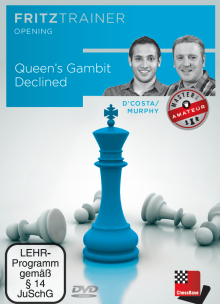
Training / Opening / Friztrainer
Queen's Gambit Declined
by Lorin D'Costa, Nick Murphy
2014
http://www.chessbase.com
E-Mail info@chessbase.com
Price Euro 27.90
Pentium-Processor at 300 Mhz or higher, 64 MB RAM, Windows XP, Windows
Vista, Windows 7, DVD drive, mouse, soundcard
The two authors Lorin D'Costa and his companion Nick Murphy take
you in this second edition of the “Master & & Amateur”
style,cover all the import key plans and ideas of the Queen’s Gambit
Declined.
In big lines they handle lines as,the Tartakower and Lasker Defence,
The exchange variation,Bf4 lines and other attempts as for example the
Catalan.
Video running time is 7 hours and 28 minutes and it comes in the
English language.
Included is a impressive data base of 87 entries plus some testing
positions to test if you have learned from the two instructive speaking
teachers!
Conclusion: Super learning material!

ChessBase Magazine issue 158
2014
February/March
http://www.chessbase.com
E-Mail
info@chessbase.com
ISSN 1432-8992
Price Euro 19.95
This ChessBase DVD is well filled with all the world
championship games and the best part is that grandmaster Daniel King
has analysed all ten games in video format!
Included is also a WorldChampionship file with excellent annotated
games:
Anand,Viswanathan (2775) - Carlsen,Magnus (2870) [E25]
World Championship Chennai (9), 21.11.2013
[Gutman,L]
1.d4! "I should have played 1.d4 from the start. That was one of my
greatest mistakes in my preparation", Viswanathan Anand after the
match. "Ich hätte von Anfang an 1.d4 spielen müssen. Dies war
einer meiner größten Fehler bei der Vorbereitung",
Viswanathan Anand nach dem Wettkampf. 1...Nf6 2.c4 e6 3.Nc3 Bb4 4.f3 d5
5.a3 Bxc3+ 6.bxc3 c5 7.cxd5 exd5 [In the match Anand-Kramnik, Bonn 2008
Im Wettkampf Anand-Kramnik, Bonn 2008, kam 7...Nxd5 was played. aufs
Brett.] 8.e3 c4!? In any case the choice of opening by Carlsen should
have ben no surprise, since his previous trainer and confidant GM Simen
Agdestein had already played this at the start of the year and
even revealed after the game, "that the Norwegian national team had
recently been lookng into this variation", Ian Rogers.
Allerdings sollte die Eröffnungswahl von Carlsen keine
Überraschung sein, da sein früherer Trainer und Vertrauter GM
Simen Agdestein bereits Anfang des Jahres so gespielt hat und
nach der Partie sogar verriet, "dass die norwegische Nationalmannschaft
sich kürzlich gerade mit dieser Variante beschäftigte", Ian
Rogers.
9.Ne2 [9.g4 Nc6 10.Ne2 leads to the game by transposition.
führt durch Zugumstellung zur Partie;
For Bezüglich 9.g3 Nc6 10.Nh3 see Biolek-Agdestein, Prag 2013
siehe Biolek-Agdestein, Prag 2013;
Once can hardly recommend Kaum zu empfehlen ist 9.e4?! dxe4 10.Bxc4
(10.Bg5 Qa5 11.Qc1 (11.Qd2!? Nbd7 12.Bxc4 0-0 13.Ne2 b5 14.Ba2 exf3
15.gxf3 Bb7 16.0-0 Bd5³) 11...Nbd7 12.Bxc4 0-0 13.Ne2 Re8
(13...b5!? 14.Ba2 exf3 15.gxf3 Bb7) 14.Rb1 Qc7 15.Bb3?! (15.Bb5 a6
16.Bxd7 Nxd7³) 15...exf3 16.gxf3 b6 17.Kf2 Ba6µ Grover-Zhou
Weigi, Dubai 2012) 10...0-0 11.fxe4 (11.Ne2 exf3 12.gxf3 Bf5 13.0-0
Nbd7 14.Bb3 Rc8 15.c4 Re8 16.Rf2 Nh5 17.Ng3 Bg6 18.Ne4 Ndf6 19.Nc3
h6³ Jambrich-Nemchenko, email 2010) 11...Nxe4 12.Nf3 Qc7 13.Qb3
Nd7 14.0-0 Nb6 15.Bd3 Be6 (15...Qxc3 16.Qb1) 16.Qc2 f5 17.Ng5 Bc4
18.Bd2 Bxd3 19.Qxd3 Qc4 20.Qh3 Nxg5 21.Bxg5 Nd5 22.Bd2 g6 23.Rae1 Nf6
24.Bh6 Rfe8 25.Qf3 Re4³ Gerola-Kunzelmann, corr 2012] 9...Nc6
[9...0-0 10.g4 (10.Qc2?! Nc6 11.e4 dxe4 12.fxe4 Qa5 13.e5 Re8µ)
10...Nc6 is a transposition of moves. ist Zugumstellung.] 10.g4
[ Abzuraten ist von 10.Ng3 cannot be
advised: 10...h5!? (Michail Krasenkow, chesspro.ru).
(Michail Krasenkow, chesspro.ru). 11.h4 a) Compare: Man sehe: 11.Qc2 h4
12.Ne2 Qe7 13.Kf2 g6 (13...b5!?µ) 14.g4 hxg3+ 15.Nxg3 Be6 16.a4
Na5 17.Ba3 Qc7 18.Bg2 Nb3 19.Rae1 0-0-0µ Joergensen-Sadowski,
email 2006; b) 11.e4 h4 12.exd5 hxg3 13.dxc6 Rxh2 14.Rg1 Kf8µ;
11...Qc7!? (11...Na5 12.e4 Nb3 13.Rb1 Qa5³ Marusenko-Pavlov, Kiev
2010) 12.Kf2 Na5 13.Qe1 (13.e4 dxe4 14.Nxe4 Nd5³) 13...Nb3³]
10...0-0 [10...Na5!? is perhaps somewhat more flexible (Krasenkow), see
Kortschnoj-O'Kelly and Aghasuryan-Mekumyan. ist vielleicht etwas
flexibler (Krasenkow), siehe Kortschnoj-O'Kelly und
Aghasuryan-Mekumyan.;
10...h6 leads to Kasparov-Polgar. führt zu Kasparov-Polgar.]
11.Bg2 Na5 [ Zeitverlust wäre 11...Qe7?! would be a
waste of time: 12.Nf4 (12.0-0!?) 12...b5 (12...Na5
13.0-0 Nb3 14.Ra2) 13.0-0 h6 14.h4 (14.e4!? dxe4 15.fxe4 Bxg4
16.Qe1²) 14...Rd8?! (14...Qd8!? 15.e4 Ne7 would be more solid
wäre solider) 15.g5 hxg5 16.hxg5 Ne8 17.e4 Nc7 18.Nxd5 Nxd5
19.exd5 Na5 20.f4 Nb3 21.Ra2 Bb7 22.Re2 Qd7 23.Re5±
Nikitin-Belinkov, Moskau 1966] 12.0-0 Nb3 Anand must have been
satisfied with his choice of opening; he obtained exactly the sort of
position he needed since he was trailing in the match - complicated and
sharp.
Mit seiner Eröffnungswahl dürfte Anand zufrieden
gewesen sein, er bekam genau den Typ Stellung, den er bei seinem
Rückstand im Wettkampf gebraucht hatte - kompliziert und scharf.
13.Ra2 In contrast to the Botvinnik Variation White does not need
a rook on e2 in order to get in e3-e4. Im Unterschied zur
Botwinnik-Variante braucht Weiß keinen Turm auf e2 um e3-e4
durchzusetzen. [The move Der Zug 13.Rb1!? has been less explored, but
in view of the counterplay for Black on the b-file it looks to make
more sense and would perhaps have been less pleasant for Carlsen to
face. ist weniger untersucht, erscheint in Anbetracht des schwarzen
Gegenspiels auf der b-Linie sinnvoller und wäre für Carlsen
vielleicht unangenehmer gewesen.] 13...b5 [13...h6 see Kasparov-Polgar
siehe Kasparov-Polgar;
13...Qa5 14.g5 Nd7 (14...Nh5 (Krasenkow) 15.Qe1 Bd7 16.Qh4 g6 17.e4
Rae8 18.Bf4 Nxf4 19.Qxf4 Bc6 20.h4²) 15.e4 Nb6 16.Qe1!? (16.h3
Na4!? (16...Nxc1 17.Qxc1 Bd7 18.Ng3 Nc8 19.Re2 Ne7 Bernasek-Hera,
Österreischische Liga 2012/13 20.f4 dxe4 21.Nxe4 Nd5 22.Nc5 Bc6
23.Bxd5 Bxd5 24.Rfe1=) 17.Qe1 f6 18.gxf6 Nxc1 19.Qxc1 Rxf6³)
16...f6 (16...Nxc1 17.Qxc1 Bd7 18.Ng3; 16...Na4 17.Rc2 Bd7 18.Ng3)
17.gxf6 Nxc1 18.Qxc1 Rxf6 19.Ng3 Na4 20.Rc2 Be6 21.e5 Rf7 22.f4 Raf8
23.Qe3²] 14.Ng3 [14.a4 hardly fits in here ist kaum am Platze
14...bxa4 15.Ng3 (15.Rxa4 a5 16.g5 Ne8 17.e4 Nc7 18.Ng3 Bd7 19.Ra2 Nxc1
20.Qxc1 a4 21.e5 Rb8 22.f4 Rb3³ (Pavel Maletin, ruchess); 15.Nf4
Bb7 16.Rxa4 Re8 17.g5 Nd7 18.h4 a5³) 15...Nxc1 16.Qxc1 Qa5 17.e4
Rb8 18.g5 Ne8³;
Etwas sinnvoller erscheint 14.g5 seems to make more
sense: 14...Nd7 (14...Nh5 15.e4 f6 16.gxf6 Qxf6
17.Be3 a5 18.Nc1 Nxc1 19.Qxc1 Rb8 20.Rb2 Qe7 21.Qd2 Rb6 22.e5 Bf5
23.Kh1 Bd3 24.Rg1 Rf7 25.Bg5= Fessler-Vozda, corr 2012) 15.e4 Nb6
16.Bf4 (16.e5? Bf5µ Gardner-Shabalov, Calgary 2012) 16...a5
(16...f6 17.gxf6 Qxf6 18.Qe1=) 17.Qe1 Ra7 18.Qg3=] 14...a5 15.g5
[ Kaum besser wäre 15.e4 would hardly be any better,
see Volkov-Smirnov, Khanty Mansiysk 2013. siehe Volkov-Smirnov, Khanty
Mansiysk 2013.] 15...Ne8 16.e4 Nxc1 [After Nach 16...Nc7 then ist
17.Be3 Rb8 18.Qe1 b4 19.axb4 axb4 20.Ne2 bxc3 21.Nxc3 Bb7 22.Qg3 Ra8
23.Rxa8 Bxa8 24.Rd1 Bc6= is possible (Maletin). möglich
(Maletin).] 17.Qxc1 Ra6 [17...Rb8 18.Qd2 Nc7 19.e5 Qe7 20.Rb1=] 18.e5
Nc7?! Carlsen is too optimistic. He wants to maintain the tension and
over-estimates his position. Carlsen ist zu optimistisch. Er will die
Spannung aufrechterhalten und überschätzt seine Stellung.
[Two alternatives appear more prudent: Vorsichtiger erscheinen zwei
weitere Alternativen: 18...b4 19.axb4 axb4 20.Rxa6 Bxa6 21.cxb4 Qb6
22.Qc3 Nc7 23.f4 Nb5 (23...Rb8 24.Ra1) 24.Qe3 Qxd4 25.Qxd4 Nxd4 26.Bxd5
c3 (Krasenkow) 27.Rc1 c2 28.Be4 Rc8 29.Kf2 g6 30.Ke3 Rc4 31.Bd3 Rc3
32.Kxd4 Rxd3+ 33.Kc5 Rc3+=;
18...g6 19.f4 Ng7 20.Rb2 Rb6 21.Qb1 (Krasenkow) 21...Qd7! 22.f5 Nxf5
23.Nxf5 (23.Rxf5 gxf5 24.Nh5 Qe7 25.Nf6+ Rxf6 26.gxf6 Qxa3 (Maletin)
27.Qc2 b4 28.Bxd5 Kh8 29.Ra2 b3 30.Rxa3 bxc2 31.Ra1 Be6 32.Bxe6 fxe6
33.Rc1 Ra8 34.Rxc2 Kg8 35.Ra2±) 23...gxf5 24.h4 h6 25.Bh3 Qe7
26.Bxf5 Qxa3 (Maletin) 27.Rg2 Qxc3 28.Bxc8 Qxd4+ 29.Rff2 Qxe5 30.Bf5
Kh8 31.Qc1 Re8 32.g6=] 19.f4? [The critical moment! Black had more
difficulties after Der kritischer Moment! Mehr Schwierigkeiten hatte
Schwarz nach 19.Rb2!? Qe7 20.Rb1 (Krasenkow) , so as to finally bring
this rook to b1: , um diesen Turm endlich auf b1 zu bringen: 20...Rb6
21.f4 b4 22.axb4 axb4 23.cxb4 Rxb4 (23...g6 24.Qe3!? Bd7 25.f5 Bxf5
26.Nxf5 gxf5 27.Rxf5 Rxb4 28.Rbf1² (Maletin)) 24.Qa3 Na6 25.Bxd5!?
(25.Rb2 Qb7 26.Rfb1 Rxb2 27.Qxb2 Qd7 28.Qb6² (Maletin)) 25...Qd8
26.Rxb4 Nxb4 27.Qxb4 Qxd5 28.Qc5²] 19...b4 20.axb4 [For equality
Zum Ausgleich reichte 20.a4 was sufficient, to deprive Black of the
b5-square for his knight: um Schwarz das Feld b5 für den Springer
wegzunehmen: 20...b3 (20...Rb6 21.f5 bxc3 22.Raf2 Na6 (22...Rb3 23.e6
fxe6 24.f6 Rb2 25.Rf3 (Maletin) 25...e5 26.Rxc3 exd4 27.Qxb2 dxc3
28.Qxc3 Ne6 29.Nf5 gxf6 30.Bxd5 Kh8 31.gxf6 Qxd5 32.f7+ Nd4 33.Qxd4+
Qxd4+ 34.Nxd4 Kg7 35.Nf5+ Bxf5 36.Rxf5 Rxf7 37.Rxa5 Rc7 38.Kf2 c3
39.Rg5+ Kf6 40.Rg1=) 23.f6 Nb4 24.fxg7 Kxg7 25.Nh5+ Kh8 26.Rxf7
(Maletin) 26...Rxf7 27.Rxf7 Be6 28.Rf6 Nd3 29.Qxc3 Rb1+ 30.Bf1 Bh3
31.Qxa5 Rxf1+ 32.Rxf1 Qxg5+ 33.Ng3 Bxf1 34.Qa8+ Kg7 35.Qa7+=) 21.Raf2
Bd7 22.f5 Bxa4 23.f6 Bd7! (23...g6? 24.Qf4 Re8 (24...Ne6? 25.Qh4 Kh8
26.Bh3) 25.Qh4 Ree6 26.Nf5 gxf5 (26...Qf8 27.Ne7+ Kh8 28.Rf3 h5 29.Bh3
Be8 30.Bg4+-) 27.Bh3 Kh8 28.Bxf5 Qg8 29.Rf3 Ne8 30.Rh3 Nxf6 31.exf6
Rxf6 32.Qxh7+ Qxh7 33.Rxh7+ Kg8 34.gxf6+- (Maletin)) 24.fxg7 Kxg7
25.Nh5+ Kh8 26.Rxf7 (26.Nf6 Ne8 27.Nxd5 Be6 28.Nf6 Nxf6 29.Rxf6 Rg8=
(Maletin)) 26...Rxf7 27.Rxf7 Be6 28.Rf6 Qg8 (Maletin) 29.g6 hxg6 30.Nf4
(30.Qh6+ Qh7 31.Qf8+ Qg8 32.Qh6+ Qh7=) 30...Bf7 31.Nxd5 Rxf6 32.Nxf6
Qf8 33.Qg5 Kg7 34.Nh5+ Kh8 35.Nf6 Kg7=;
A more energetic move seems to be Energischer erscheint 20.f5!? (Boris
Gelfand, chesspro) 20...bxc3!? a) 20...b3 21.Raf2,; b) 20...Nb5 21.axb4
axb4 22.Rxa6 Bxa6 23.f6 g6 24.Qf4! (24.e6 fxe6 25.Qe3 Bc8 26.cxb4 Nd6=
(Krasenkow)) 24...Qb6 25.Qh4 h5 26.Nxh5 bxc3 27.Kh1! Nxd4 28.Ng3 Ne6
29.Nf5! gxf5 30.Qh5! Qb7 31.Bh3 d4+ 32.Bg2+-; 21.f6 g6 22.Qxc3 (22.Qf4
Ne6 23.Qh4 Qb6 24.Ne2 Qb3 25.Nc1 Qb6 26.Ne2=) 22...Rb6 23.Qxa5 Rb3=
(Maletin);
And Auch 20.Raf2!? is also interesting, so as to mobilise all his
resources: ist interessant, um alle Resourcen zu mobilisieren: 20...Nb5
a) 20...bxc3 21.Qxc3 a4 22.Qe3 Rb6 23.f5 Rb3 24.Qf4 Rd3 (24...c3 25.f6
Ne6 26.Qh4 Ba6 27.Bh3±) 25.Nh5 Nb5 26.e6 Rxd4 27.Qe5 Qxg5
28.Nf4±; b) 20...b3 21.f5 Kh8 22.Nh5 Rb6 23.Qe3±; 21.axb4
axb4 22.cxb4 Nxd4 23.f5 Bb7 (23...Nb3 24.Qd1 Bb7 25.Qh5) 24.Nh5
(Maletin) 24...Qb6 25.Qe3 Qa7 26.e6 fxe6 27.Qe5 Bc8 28.b5 Nxb5 29.f6
Ra2 (29...Qd4 30.fxg7 Rf5 31.Qb8 Qc5 32.Kh1+-) 30.Bxd5 Qb6 31.Bxc4 Rxf2
32.Rxf2 Nd4=] 20...axb4 21.Rxa6 Nxa6 22.f5 [22.cxb4 Nxb4 23.f5 g6
24.Qd2 Nc6=] 22...b3 [22...bxc3 23.Qxc3 g6 24.Qe3 (24.f6 Nc7 25.Rb1 Ne6
26.Qd2 Qc7 27.Ne2= (Maletin)) 24...Nc7 25.h4 Bxf5 26.Nxf5 gxf5 27.Rxf5
Ne6 28.Rf6 Qa5 29.Kh2=] 23.Qf4 [23.f6 g6 24.Qf4 Kh8!? 25.Qh4 b2 26.Qh6
Rg8 27.Rf4 b1Q+ 28.Bf1 Qd1! 29.Rh4 Qh5 30.Nxh5 gxh5 31.Qxh5 Bf5 32.Qxf7
Nc7³;
23.Nh5 Nc7 24.Qe3 Kh8 25.h4=;
23.h4!? (Alexej Dreev, chessnews.ru) 23...Nc7 24.h5 Ne8 (24...Nb5?!
25.f6 Be6 26.g6 hxg6 27.hxg6 fxg6 28.Qg5 Nxc3 29.Qxg6 Qc7 30.Nh5+-)
25.Qf4 (25.f6 gxf6 26.gxf6 Kh8 27.Ne2 Rg8 28.Nf4 Nc7³) 25...Qa5
26.h6 g6 27.fxg6 hxg6 28.Nh5 Bf5 29.Bh3 Bxh3 30.Nf6+ Kh8 31.Nxe8 f6
32.e6 Qa2 33.Rf2 Qb1+ 34.Kh2 Qe1 35.Nxf6 Bxe6= (Maletin)] 23...Nc7
[23...Kh8?! 24.Nh5 Nc7 25.e6 Ne8 (25...fxe6 26.Nxg7 Kxg7 27.f6+ Kg8
28.f7+) 26.exf7 Rxf7 27.f6 g6 28.Re1 Nc7 29.Ng7 Kg8 30.h4²]
24.f6!? [24.Qh4 Kh8 25.Nh5 Nb5 (25...b2 26.f6 g6 27.Ng7 Nb5 (Mikhail
Golubev, chess today) 28.Qf2 Nxc3 29.Qxb2 Ne4 30.h4 Kg8 31.Qb4 Qc7=)
26.e6 fxe6 27.f6 gxf6 28.Nxf6 Qe7 29.Rf2 Rf7 30.g6 Rg7 31.Nh5 Kg8=]
24...g6 [24...gxf6 25.Qh4 f5 (25...Kh8 26.Rxf6 Ne6 27.Bxd5 Qxd5 28.Rh6
Nxg5 29.Qxg5 Qf3 30.Rf6 Qg4 31.Qh6 Kg8 32.Rb6 Be6 33.Kf2 Qg6 34.Qxg6+
hxg6 35.Ke3 Kg7 36.Rb5=) 26.Nh5 Ne8 27.Nf4 Be6 28.Rf3 Ng7 29.Rh3 Re8
30.Nxd5 Bxd5 31.Qxh7+ Kf8 32.Qh8+ Ke7 33.Qxg7 b2 34.Qf6+ Kd7 35.Qd6+
Kc8 36.Qa6+ Kc7=] 25.Qh4 Ne8 Magnus Carlsen has defended more or less
accurately and is hoping for the best.
Magnus Carlsen hat sich mehr oder weniger akkurat verteidigt, und
hofft auf das Beste.
26.Qh6 [26.Ne2 Be6 27.Nf4 Qa5 28.Nxe6 (Maletin gives Maletin gibt
28.Bh3 Bxh3 29.Qxh3 b2 30.e6 (30.Ne6 Qa1 31.Nxf8 Kxf8 32.e6 Nd6 33.Qh6+
Ke8 34.exf7+ Nxf7 35.Qh3 Kd8 36.Qg2 b1Q 37.Qxd5+=; 30.Nxg6 hxg6 31.e6
Qa1 32.e7 Nxf6 33.exf8Q+ Kxf8 34.gxf6 Kg8=) 30...Nd6 (30...Qa1 31.e7
b1Q 32.exf8Q+ Kxf8 33.Nxd5) 31.Nxg6 hxg6 32.Qh6 Nf5 33.Rxf5 b1Q+ 34.Rf1
Qxf1+ 35.Kxf1= with equality in each case. jeweils mit Ausgleich an)
28...fxe6 29.Bh3 Nc7 (29...Qa6 30.Qf2 Rf7 31.Qb2 Ra7 32.Bg4 Kf8 33.Qf2
Qb6 34.Qh4 b2 35.Qh6+ Kg8 36.Qh3 Kf8=) 30.f7+ Rxf7 31.Rxf7 Kxf7
32.Qxh7+ Kf8 33.Qh8+ Ke7 34.Qf6+ Kd7 35.Bxe6+ Nxe6 36.Qf7+ Kd8 37.Qf6+
Kc7 38.Qe7+ Kb8 39.Qxe6=] 26...b2 27.Rf4!? [27.Ne2 Be6 28.Nf4 Qa5
29.Nxe6 fxe6 30.Bh3 Qa6 31.Bg4 Rf7 32.Qh3 Nc7 33.Qg2 Qa2 34.Qc2 Rf8
35.f7+ Kg7 36.Qf2=] 27...b1Q+ 28.Nf1?? [Anand overlooks Black's reply.
Anand übersieht die schwarze Antwort. Zum Ausgleich reichte 28.Bf1
was enough for equality: 28...Qd1! 29.Rh4 Qh5 30.Nxh5
gxh5 31.Rxh5 Bf5 32.g6! (32.Bh3 Bg6 33.e6 Nxf6 34.gxf6 Qxf6³)
32...Bxg6 33.Rg5 Nxf6 (33...Qa5 34.Rg3 Qa3 35.h4) 34.exf6 Qxf6 35.Rxd5
Qf3 36.Rc5 Qxc3 37.Rxc4= (Krasenkow)] 28...Qe1! [But not Aber nicht
28...Qd1?? 29.Rh4 Qh5 30.Rxh5 gxh5 31.Ne3 Be6 32.Bxd5+-] 0-1
The tournament file is good for over 577 entries where a small 23 of
them cover excellent annotations.
As for example the following game: Schenk,Andreas (2489) -
Areshchenko,Alexander (2714) [D85]
Bundesliga 1314 Germany (6.2), 15.12.2013
[Areshchenko/Meyer,CD]
1.d4 Nf6 2.c4 g6 3.Nc3 d5 4.cxd5 Nxd5 5.e4 Nxc3 6.bxc3 Bg7 7.Nf3 c5
8.Bb5+ Neben dem weit ausanalysierten und erfolgreichen 8.¦b1
sowie dem flexiblen 8.¥e3 ist dieses Läuferschach eine nicht
seltene, relativ harmlose Fortsetzung in der Abtauschvariante der
Grünfeld-Indischen Verteidigung ("a drawish variation", AA) - auf
Großmeister-Ebene indes eher mit durchwachsenen Resultaten.
8...Nc6 [8...Bd7 9.Bxd7+ Nxd7 (9...Qxd7) 10.0-0 0-0 11.Rb1 (11.Bg5 h6
12.Bh4 cxd4 13.cxd4 Nb6 14.Rc1 Qd7 15.Ne5 Bxe5 16.dxe5 Qe6 17.Rc7 Rfd8
18.Qc1 g5 19.Bg3 Rac8÷ /=, remis/51, Kryakvin,D (2573) -Novik,M
(2451), St. Petersburg 2013) 11...Qc7 12.e5 Nb6 13.Qb3 Rfd8 14.dxc5
(¹14.Ng5!?²) 14...Qxc5 15.Be3 Qd5÷ /=, remis/34,
Ragger,M (2561) - Areshchenko,A (2667), Germany 2010] 9.0-0 0-0 [Die
Hauptvariante lautet 9...cxd4 10.cxd4 0-0 11.Be3 Bg4 12.Bxc6 bxc6
13.Rc1 mit gleichen Chancen, z.B. 13...Qa5 14.Qd2 (14.Rxc6 Qxa2 15.Rc7
Qe6 16.h3 Qd6 17.Rc5 Bxf3 18.Qxf3 a5 19.e5 Qd7 20.Ra1 a4= remis/26, I.
Sokolov - P. Leko, Sarajevo 1999) 14...Qxd2 15.Nxd2 Rfd8 16.Nb3 a5
17.Rxc6 a4 18.Nc5 Bxd4 19.Bxd4 Rxd4= remis/32, Bruzon Batista,L (2699)
- Dominguez Perez,L (2757), Linares 2013] 10.Be3 Bg4 [Oder:
I 10...Qa5 11.Qa4!?÷;
II 10...cxd4 11.cxd4 Bg4 geht unter Zugumstellung wieder über zur
Hauptvariante, deren Resultate laut ChessBase-Statistik im Vergleich zu
unserem Partiezug allerdings ungünstig für Schwarz sind.]
11.dxc5!? Indem Weiß sein Bauernzentrum freiwillig auflöst,
hofft er, mit der Stellungsöffnung unkomplizierteres Spiel zu
erlangen. [Oder z.B.:
I 11.d5 Ne5 12.Be2 Nxf3+ 13.Bxf3 Bxf3 14.Qxf3 Qa5÷
/=(14...Bxc3÷ /=) ;
II 11.Bxc6 bxc6 12.Rc1 Qa5 13.Qe2 Rfd8 14.Rfd1 Bxf3 (14...Qa4 15.Rd2
(¹15.h3 Bxf3 16.gxf3) 15...e5 16.Bg5?! (16.Qd1 Qxd1+
17.Rcxd1÷ /=) 16...Rd7 (¹16...f6) 17.dxe5÷ 0:1/45,
Shulman,Y (2542) - Wang,Y (2705), Ningbo 2013) 15.gxf3 cxd4 16.cxd4
Bxd4 17.Bxd4 (17.Rxc6 Bxe3 18.Rxd8+ Rxd8 19.Qxe3 Qxa2 20.Qc3!?³)
17...Rxd4 18.Rxd4 Qg5+ 19.Kf1 Qxc1+ 20.Qd1 Qc5 (20...Qf4!?) 21.Qd2
Rb8µ 0:1/48, Ivanov,M (2403) - Khalifman,A (2642), Minsk 2012]
11...Qc7 [11...Bxc3 12.Rb1 Qxd1 13.Rfxd1 Rfd8= , AA] 12.h3?!
Womöglich eine Neuerung, die aber keineswegs besser ist als die
bekannten Alternativen. Weiß zwingt den Läufer zur
Erklärung und will mit der Dame auf f3 wiedernehmen. Dort steht
sie aber eher ungünstig, überdies plant Schwarz, sowieso auf
f3 zu tauschen und nimmt das Entwicklungstempo mittels ¦d8 gerne
mit. Alternativen, z.B.: [I 12.Bxc6 Qxc6 13.Qc2 Bxf3 14.gxf3 f5÷
remis/49, Xu,J (2486) - Wang,Y (2734), Ningbo 2011;
II <12.Qb3 Bxf3 13.gxf3 Be5 14.h3 Bf4³ 0:1/30, Manor,I (2491) -
Sutovsky,E (2695), Israel 2011;
III 12.Rb1!? an dieser Stelle wohl ebenfalls unerprobt 12...Rfd8 a)
<12...Rad8 13.Qc1 Bxf3 14.gxf3 Ne5 15.Be2 Nd3 16.Bxd3 Rxd3
17.Rd1² , AA; b) 12...Ne5 13.Be2 Nd7! 14.Nd2 (14.Qd5 b6 15.cxb6
axb6 16.Qg5 Bxf3 17.Bxf3 Ne5 18.Bd1 Nc4 19.Bf4 e5=) 14...Bxe2 15.Qxe2
Rfd8© , AA; c) 12...Bxc3 13.Qb3 Bg7 14.Bxc6 bxc6 15.Qb7 Rac8= ,
AA; 13.Qc1!? Bxf3 14.gxf3÷] 12...Rad8 [12...Rfd8!? 13.Qb3
(13.Qe2?! Bxf3 14.Qxf3 Bxc3³) 13...Bxf3 14.gxf3 Be5÷
/=(14...Ne5!? 15.Kg2 a6 16.Be2 Nd7 17.Qb4 e6 18.Rab1 Rab8" , AA) ]
13.Qe2?! [Weiß möchte partout seine Bauernstellung am
Königsflügel intakt halten, aber dynamischer war 13.Qb3! Bxf3
14.gxf3÷ , z.B. 14...Be5 15.Bxc6 bxc6 16.Rab1 Bh2+ (16...Bf4
17.c4 a5=) 17.Kg2 Bf4 18.c4 f5 19.Qb7 fxe4 20.Qxc7 exf3+ 21.Kxf3 Bxc7+
22.Ke2 Rb8= , AA] 13...Bxf3 14.Qxf3 Bxc3 15.Bf4?! [Danach gerät
Weiß ins Hintertreffen, den Vorzug verdiente ¹15.Rab1!?
eingedenk diverser taktischer Ideen, z.B. 15...Nd4 (15...Bd2 16.Bxc6
Qxc6 17.Rfd1 Bxe3 18.Qxe3 Rxd1+ 19.Rxd1 Rc8=) 16.Qg3! Nxb5 (16...Qa5
17.Bh6! Nxb5 18.Rxb5 Qxb5 19.Qxc3 f6 20.Bxf8 Kxf8 21.e5 Rd3 22.Qa1 Kg7
23.exf6+ exf6 24.Rd1=) 17.Rxb5 Qc6 (17...Be5 18.Qf3) 18.Rfb1 Rd7 "and
this position is slightly better for Black", AA/CDM] 15...Be5 Wonach
verschiedene Transformationen durchzurechnen und einzuschätzen
sind, was höchste Ansprüche an beide Akteure stellt.
16.Bxc6 [Die alternative Abwicklung ins Schwerfiguren- bzw.
Turmendspiel nach 16.Bxe5 Qxe5 (<16...Nxe5 17.Qe3 a6 18.Be2 Nc6
19.Rfd1 Rxd1+ 20.Rxd1 Rd8³) 17.Bxc6 bxc6 18.Qa3 Rd7 19.Rad1 Rfd8
20.Rxd7 Rxd7³ und weiter z.B. 21.Qa6 Qe6 (21...Rc7 22.Qc4) 22.Qc8+
Kg7 23.f4 Rd4 24.Qxe6 fxe6 25.Rb1! .¦b7 erscheint gerade noch
zum Remis ausreichend.] 16...Bxf4 [16...bxc6 17.Bxe5 Qxe5 18.Qa3 ist
Zugumstellung zur vorigen Variante.] 17.Bxb7 Be5 [Eine Spur genauer war
¹17...Bh2+ 18.Kh1 Be5 19.Rab1 Qxc5³] 18.Rab1 Qxc5 19.Bd5 [Und
hier hätte Weiß nach ¹19.Rfc1 Qa5 20.Bd5 e6 21.Bb3 Rd2
22.Rd1 weiterhin nur geringfügig schlechter gestanden.] 19...e6
20.Rfc1 Qe7 21.Bb3 h5!? Während der weiße Läufer auf
Granit beißt, winken dem schwarzen Antipoden schöne
Perspektiven auf den Diagonalen a7-g1 und b8-h2, zudem
Verstärkungen von seinen Schwerfiguren-Kollegen.
22.Rd1 Bd4?! [Den Vorzug verdienten:
I ¹22...h4 23.Qe3 Rxd1+ 24.Rxd1 Rd8 25.Rxd8+ Qxd8³ strebt
unverzüglich auf das - analog der Partie - thematische Endspiel
£+¥ vs £+¥ mit den "ungleichen" Läufern zu.
Mit der Partiefortsezung indes vermeidet Schwarz zwar zunächst
weitere Vereinfachung und gibt dem Gegner mehr
Stolpermöglichkeiten, aber räumt ihm auch eine zähe
Verteidigungsmöglichkeit ein.;
II ¹22...Rxd1+ 23.Rxd1 h4 , AA] 23.Rd2?! [Der ebenso subtile wie
leicht zu übersehende Verteidigungszug war ¹23.Qf4!? mit
folgenden Ideen: 23...Rd7 (23...g5 24.Qf3 h4 25.Bc2 Be5³ , AA;
23...e5 24.Qh6!" , AA) 24.Ba4! (24.e5?! Rfd8) 24...e5 25.Qh6" und nach
Öffnung der Schrägen a2/g8 hat Weiß ausreichendes
Gegenspiel.] 23...Rd6! 24.Rbd1 Rfd8 25.Rc1 [25.g3!? h4 26.Kg2 hxg3
27.fxg3] 25...a5 26.Rc4 [26.g3!? h4 27.Kg2 hxg3 28.fxg3 Be5 29.Rxd6
Rxd6 30.Rd1³] 26...h4! 27.Rd1 Bb6 [27...Kg7³ , AA] 28.Rxd6?
Und das ist nach mehreren Ungenauigkeiten bzw. Auslassungen der Fehler,
der die schwarzen Aktivitäten vehement anwachsen lässt.
[AA/CDM: Notwendig war 28.Rcc1T , um - falls möglich - endlich
Entlastung durch Turmtausch zu finden: 28...Qg5 a) 28...Rxd1+ 29.Rxd1
Rxd1+ 30.Qxd1 (30.Bxd1 Qb4) 30...Qb4 31.Bc2 Qa3 32.Bb3 Qb2 33.Qc2 Qd4
34.Kf1³; b) 28...Bd4!? 29.Qf4 g5 30.Qf3 Kg7³; 29.Rxd6 Rxd6
30.Rd1 Bd4 (30...Rd2 31.Rxd2 Qxd2 32.Kf1³) 31.Qg4 Qf6 32.Qf3 Qe5
33.Qg4³] 28...Qxd6µ 29.Rc1?! [Oder:
I 29.Qf6 Qd2 30.Rc2 Qe1+ 31.Kh2 Qxe4 32.Rc4 Qf5 33.Qxh4 (33.Qxf5
gxf5µ) 33...Kg7!, ? und der schwarze Angriff rollt: (33...Qxf2?!
34.Qxf2 Bxf2 35.Rc2) 34.Bc2 a) 34.a4? Bxf2 35.Qf4 (35.Qxd8 Qe5+-+)
35...Rd3!-+; b) 34.g4 Qb5! 35.Rf4 (<35.Qg3 a4! 36.Rxa4 Rc8!-+
.¦c1 mit vernichtendem Angriff) 35...Qe5 36.Qg3 Bc7 37.Rc4 Qxg3+
38.fxg3 Rd2+ 39.Kh1 Bxg3µ; c) 34.Rf4 Qe5! 35.Qg3 Bd4! 36.h4
(36.Bc2 f5-+) 36...Qc5 37.Kh3 a4 38.Bxa4 Be5 39.Rc4 Qxc4 40.Qxe5+ f6-+;
34...Qe5+ (34...Qxf2 35.Qxf2 Bxf2µ) 35.Qg3 Qf6 36.Bb3 (36.f4 Rd4!
37.Rc6 (37.Rxd4 Qxd4 38.h4 Qg1+ 39.Kh3 Bf2µ) 37...Ba7 38.Qg5
Qxf4+ 39.Qxf4 Rxf4µ) 36...Bxf2 37.Qf4 Qxf4+ 38.Rxf4 Rd2µ;
II 29.Rc2? verliert auf mehrerlei Weise, z.B.: 29...Qe5 (29...Qb4
30.Kh2 (30.Re2 a4 31.Bc2 Rd2 32.a3 Qd4 33.Rxd2 Qxd2-+) 30...Rd2 31.Qf4
Rxc2 32.Bxc2 Bc5-+) 30.a4 Bc5 31.Ra2 (31.Re2 Qa1+ 32.Kh2 Bd4 33.g3
(33.e5 Bxe5+ 34.g3 Qf1-+ 35.Rxe5 (35.Qe4 Bd4 36.Qxh4 Rb8) 35...Rd2)
33...hxg3+ 34.Qxg3 Be5 35.f4 Qf1 36.Rf2 Rd2-+) 31...Rd4 32.Re2 Bd6-+]
29...Qb4! 30.Bxe6? Eine Panikreaktion in nahezu aussichtsloser
Situation. [Andere Möglichkeiten:
I 30.a4? Bxf2+ 31.Qxf2 Qxb3 und vermutlich -+;
II 30.Qf4? a4 31.Bc2 e5! (<31...Qd2 32.Qxd2 Rxd2 33.Bxa4 Rxf2
34.Rc8+ Kg7 35.Rb8 Rxa2+ 36.Rxb6 Rxa4 37.e5 Ra5 38.Rb4 g5 39.Re4 Kg6
40.Re1 Ra4 und vermutlich -+) 32.Qf6 (32.Qxe5 Qd2-+; 32.Qxh4 Rd2-+
33.Rb1 Qd6) 32...Rd6 33.Qxe5 (33.Qf3 Rd2-+) 33...Rd2-+;
III 30.Qc3 Qxe4 31.Rd1 Rxd1+ 32.Bxd1 mag noch das geringste Übel
sein, freilich ebenfalls mit trefflichen Gewinnchancen für
Schwarz, etwa nach dem weiteren 32...Qf4µ (32...e5µ;
32...a4µ) ] 30...fxe6 31.Qg4 Kg7 [Oder auch 31...Bxf2+!-+ 32.Kh1
(32.Kxf2 Qd2+ 33.Kf3 Rd3#) 32...Kh7 (<32...Kh8 33.Qxg6; 32...Kg7
33.Rc7+ Kh8 ist Zugumstellung zum Text) 33.Rc7+ (33.Rf1 Bg3 34.Rf7+ Kh6
35.Rf1 Qc4) 33...Kh8 34.Rc1 Qd2 35.Rf1 Kh7 36.Qxe6 Bg3 usw.] 32.Qxe6
[32.Qxh4 Rd2-+] 32...Bxf2+-+ [32...Rf8-+] 33.Kh1 [33.Kh2 Qd6+] 33...Bg3
34.e5 [34.Rf1 Rf8] 34...Qf4 35.Qe7+ Kh6 36.Rg1 Rd2 - Weiß gab
auf.
Ein Beitrag zum immergrünen Thema "Schwerfiguren und
ungleichfarbige Läufer (Transformationen)". Der hohe Favorit
konnte sich mit gekonnter Strategie und Technik durchsetzen.
Überhaupt war der ukrainische Großmeister Alexander
Areshchenko mit 2 aus 2 Werders Mann des Bundesliga-Wochenendes im
Bremer Weserstadion. 0-1
New is also the new Interactive video trainings,as Daniel King with his
„Move by Move“, Oliver Reeh “Tactics", and the great Karsten
Müller on Endgames! The openings articles cover: Schandorff:
Caro-Kann B19 1.e4 c6 2.d4 d5 3.Nc3 dxe4 4.Nxe4 Bf5 5.Ng3 Bg6 6.h4 h6
7.Nf3 e6 8.Ne5 Bh7, Illingworth: Sicilian Defence B42 1.e4 c5 2.Nf3 e6
3.d4 cxd4 4.Nxd4 a6 5.Bd3 Qb6, Kuzmin: Sicilian Defence B52 1.e4 c5
2.Nf3 d6 3.Bb5+ Bd7 4.c4, Antic: French Defence C11 1.e4 e5 2.d4 d5
3.Nc3 Nf6 4.e5 Nfd7 5.f4 c5 6.Nf3 Be7 7.f4 b6, Moskalenko: French
Defence C18 1.e4 e6 2.d4 d5 3.Nc3 Bb4 4.e5 c5 5.a3 Ba5, Stohl: Italian
Game C54 1.e4 e5 2.Nf3 Nc6 3.Bc4 Bc5 4.c3 Nf6 5.d4 exd4 6.e5 d5 7.Bb5
Ne4 8.cxd4 Bb6 9.Nc3 0-0 10.Be3 Bg4 , Krasenkow: Semi-Tarrasch D41 1.d4
d5 2.c4 e6 3.Nc3 Nf6 4.Nf3 c5 5.cxd5 Nxd5 6.e4 Nxc3 7.bxc3 cxd4 8.cxd4,
Sumets: Grünfeld Defence/Schlechter Defence D94 1.d4 d5 2.c4 c6
3.Nc3 Nf6 4.e3 g6 5.Nf3 Bg7 6.Bd3/Be2 0-0 7.0-0 dxc4 8.Bxc4 Bg4 9.h3
Bxf3 10.Qxf3 Nbd7 11.Rd1 e5, Gutman: Nimzoindian Defence E25 1.d4 Nf6
2.c4 e6 3.Nc3 Bb4 4.f3 d5 5.a3 Bxc3+ 6.bxc3 c5 7.cxd5 exd5 8.e3 c4,
Postny: Nimzoindian Defence E39 1.d4 Nf6 2.c4 e6 3.Nc3 Bb4 4.Qc2 0-0
5.Nf3 c5 6.dxc5 Na6 7.g3 Nxc5 8.Bg2 and at last Marin on the
NimzoIndian Defence E55 1.d4 Nf6 2.c4 e6 3.Nc3 Bb4 4.e3 0-0 5.Bd3 d5
6.Nf3 c5 7.0-0 dxc4 8.Bxc4 Nbd7 9.Qe2 b6 10.Rd1 cxd4 11.exd4 Bb7 12.Bd2.
Other DVD columns are King Move by Move,Reeh Tactics,Müller
Endgames,Rogozenko Strategy and Knaak Opening trap.
Opening Videos cover Bojkov Sicilian 1.e4 c5 2.Nf3 e6 3.b3,Shirov
Semi-Slav Botvinnink Variation 1.d4 d5 2.c4 e6 3.Nc3 c6 4.Nf3 Nf6 6.Bg5
h6 6.Bh4 dxc4 7.e4 b5 8.e5 g5 9.Nxg5 hxg5 10.Bxg5 Nbd7 11.g3 and Marin
on the Queen’s Gambit Exchange Variation 1.d4 d5 2.c4 e6 3.Nc3 Nf6
4.cxd5 exd5 5.Bg5 Nbd7 6.e3 h6 7.Bh4 Be7 8.Bd3 c6.
Included is a eye catching booklet in the German and English language.
Conclusion: Super
material!
The New Winawer Report by Sean Coffey
http://www.irlchess.com/tnwr/
is a free, monthly electronic newsletter on the theory, practice,
and history of the French Winawer.
Price: Free
Sean Coffey wrote me: (In fact I had originally started a comprehensive
update of Moles {The French Defence Main
Line Winawer,Batsford 1975} to the present day, line by line and word
by word; but based on what I completed, this would take about 2,500
pages in the same format today. The newsletter aims to keep the same
depth and approach as Moles, though.
Conclusion: High quality
material!






